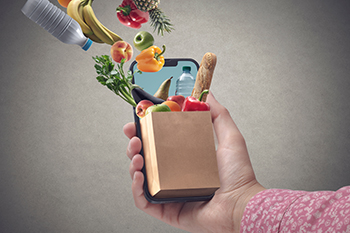By Doug Baker, Vice President, Industry Relations, FMI

As I’ve grown in my role at FMI and taken on new subject matter areas like technology, I have to admit, I’ve become a gadget guy. I’ve learned about apps, robots, voice activation technology, artificial intelligence and more. I’m
constantly in aww of the new technologies companies are creating—especially in the area of technology that can support the food industry.
We’ve got some unique circumstances facing the food industry currently. While we know from our 2022 The Food Retailing Industry Speaks report that food retailers and suppliers are facing pressures like inflation, supply chain issues and workforce challenges, we also know from our U.S. Grocery Shopper Trends research that shoppers are finding ways to deal with higher food prices and in some cases, the weekly
grocery spending is less than it was at the beginning of 2022.
In this complicated environment, how can the food industry be bold and continue to grow their customer base while keeping costs in check? Well, we live in the area of technology and there are some different options out there to consider.
Take for example Upside, a digital company offering personalized promotions through an easy-to-use consumer app. I recently spoke with Tyler Renaghan, vice president of grocery at Upside, and he shared some effective strategies for grocers to consider capturing new customers. “Grocers have to reach consumers all along their buying journey, like when they're running errands and deciding where to buy groceries,” share Renaghan. “Joining digital marketplaces like Upside is a great way to get more eyeballs on your brand (to open the top of the funnel) and guide them to your store to improve your bottom line (with same-store profit).”
But what about upfront costs to consider and already tight margins that limit experimentation? Renaghan shared, “With the right partner, you can leverage the data you already have to analyze and profitably influence consumer buying patterns on a
one-on-one basis, in real-time. When you become a regular part of a customer’s routine, you’ll win yourself a loyal consumer.”
Renaghan also stressed the importance of customer loyalty programs and that in this current environment investment in these programs was certain to have long-term benefits.
There are several other FMI Associate Members that come to mind that provide food retail services driving consumer incentives and loyalty. Catalina, Collective Bias, Europac, Eversight, InMarket and Inmar are influencers driving ROI and uplifting profitable growth for brands.
So, what’s the lesson to take away? Even in this current environment, there are opportunities and new technology investments that support your existing business strategies are just one way to be bold. Innovations that allow grocery retailers to offer new and improved products and services can increase competition and loyalty in the market. I urge you to take advantage of FMI’s technology resources and maybe even consider a MarkeTechnics opportunity to help you and your team evaluate companies to support your innovation strategy.


 Industry Topics address your specific area of expertise with resources, reports, events and more.
Industry Topics address your specific area of expertise with resources, reports, events and more.
 Our Research covers consumer behavior and retail operation benchmarks so you can make informed business decisions.
Our Research covers consumer behavior and retail operation benchmarks so you can make informed business decisions.
 Events and Education including online and in-person help you advance your food retail career.
Events and Education including online and in-person help you advance your food retail career.
 Food Safety training, resources and guidance that help you create a company food safety culture.
Food Safety training, resources and guidance that help you create a company food safety culture.
 Government Affairs work — federal and state — on the latest food industry policy, regulatory and legislative issues.
Government Affairs work — federal and state — on the latest food industry policy, regulatory and legislative issues.
 Get Involved. From industry awards to newsletters and committees, these resources help you take advantage of your membership.
Get Involved. From industry awards to newsletters and committees, these resources help you take advantage of your membership.
 Best practices, guidance documents, infographics, signage and more for the food industry on the COVID-19 pandemic.
Best practices, guidance documents, infographics, signage and more for the food industry on the COVID-19 pandemic.
